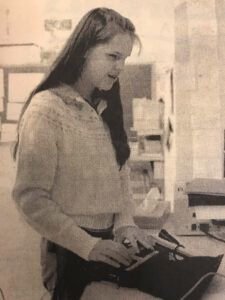Growing into Braille Technology
At five years old, an age when most kindergarteners were just beginning to learn individual letter names and sounds, I remember working with the Perkins Brailler. The Perkins Brailler is similar to a typewriter and produces braille on paper instead of producing it electronically. At ten years old, I was proficient in braille and received a Braille N’ Speak 640 (an electronic braille note-taker). I was on cloud nine! Until this point, I had exclusively used my Perkins Brailler to do my homework. In order to make my homework accessible to my sighted teachers, I needed assistance from a paraprofessional or my father. They would interline all of my assignments, a process where they would transcribe in print below each braille line. Using the Braille n’ Speak was like having my own mini computer, allowing me to create and edit documents and print homework for my teachers independently. The Braille n’ Speak was also a lot lighter and easier to carry around than the Perkins Brailler.
 Over the years, I upgraded my braille technology with newer models. As an adult, I use a braille note-taker that runs on the Android platform called a Braille Note Touch Plus. The Braille Note Touch Plus is an Android tablet with a refreshable braille display attached. I also use a refreshable braille display called the Mantis which is a QWERTY keyboard with a refreshable Braille display attached. Both of these devices can pair with a laptop computer and I can easily read what is on the laptop screen using the braille display as well as listen to it.
Over the years, I upgraded my braille technology with newer models. As an adult, I use a braille note-taker that runs on the Android platform called a Braille Note Touch Plus. The Braille Note Touch Plus is an Android tablet with a refreshable braille display attached. I also use a refreshable braille display called the Mantis which is a QWERTY keyboard with a refreshable Braille display attached. Both of these devices can pair with a laptop computer and I can easily read what is on the laptop screen using the braille display as well as listen to it.
Why all this complicated braille technology? Why not just use devices that talk? I will tell you why. Braille is critical to my independence. Taking braille out of my technology is like taking print away from a sighted person. Would you like to just listen to your favorite website or magazine? Would you rather receive a long audio message than a detailed email?
For young students today, there are many devices to learn braille at an early age. Devices like the Braille Buzz and Taptilo are designed to help teach braille through play. The Braille Buzz, made by American Printing House for the Blind, teaches both braille and phonics. As the name alludes to, the Braille Buzz is shaped to resemble a bumblebee, encouraging practice with braille characters and phonics, similar to a variety of audio-based toys that teach print writing. The Taptilo teaches the same thing; however, it uses a refreshable braille display and braille cells where the students can create their own braille to interact with the device.


